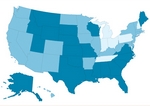Business
H1N1: Same code for diagnosis, new one for vaccine
■ CPT codes are the same for all flu, but H1N1 has separate procedure codes.
By Victoria Stagg Elliott — Posted Nov. 23, 2009
- WITH THIS STORY:
- » Related content
With influenza widespread in 48 states -- mostly because of A(H1N1) -- there are questions about how to code for vaccine and treatment.
The CPT diagnosis code is the same as any other influenza immunization visit, and the usual CPT office visit codes should be used for testing and treatment services.
CPT codes specific to H1N1 vaccine are 90470 for administration and counseling and 90663 for the vaccine itself, according to a Sept. 28 American Medical Association statement.
But to track cases more thoroughly, the Centers for Disease Control and Prevention's National Center for Health Statistics issued new ICD-9 codes effective Oct. 1 for patients diagnosed with influenza.
It said the number 488.0 should be used for influenza due to identified avian influenza virus, and 488.1 is the code for influenza due to identified novel A(H1N1) influenza virus.
The ICD-9 code used when providing the influenza vaccine by itself is V04.81 -- "need for prophylactic vaccination and inoculation against influenza." If pneumococcal and influenza vaccinations are given together, V06.6 -- "need for prophylactic vaccination and inoculation against streptococcus pneumoniae and influenza" -- should be noted.
If other services are provided, standard evaluation and management codes can be used, along with modifier 25.
HCPCS G9141 is for administration, and HCPCS G9142 is for the vaccine for Medicare patients.
This flu vaccine season has been confusing because of supply hiccups and the availability of seasonal and pandemic vaccines. Demand has been high, but vaccines have been rolling out more slowly than expected.
For instance, a Gallup Poll released Nov. 10 found that 20% of parents surveyed had tried to get the vaccine for their children but couldn't do so. When adults with or without children were asked why they had not received it, 19% said they had not tried because they didn't think they could. Another 17% had attempted to get vaccinated but couldn't.
And while the CDC provides the H1N1 vaccine and related supplies for free, how insurers handle billing for this product and service varies widely. Experts recommend contacting insurers directly to determine how they are handling the situation.
More than 41 million doses of H1N1 vaccine were allocated as of Nov. 10, and 250 million doses are expected before the season ends. The CDC predicts that 115 million doses of seasonal immunizations will be distributed by the end of November.












